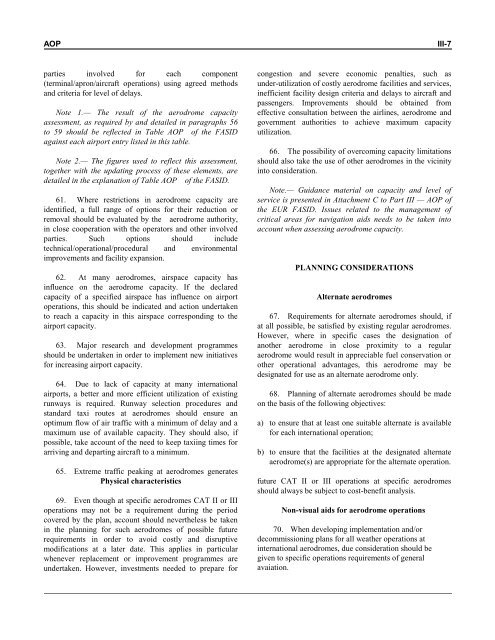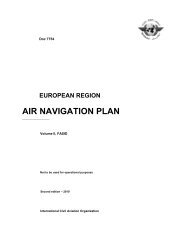7754 Vol 1 Flyleaf - ICAO Public Maps
7754 Vol 1 Flyleaf - ICAO Public Maps
7754 Vol 1 Flyleaf - ICAO Public Maps
Create successful ePaper yourself
Turn your PDF publications into a flip-book with our unique Google optimized e-Paper software.
AOP III-7<br />
parties involved for each component<br />
(terminal/apron/aircraft operations) using agreed methods<br />
and criteria for level of delays.<br />
Note 1.— The result of the aerodrome capacity<br />
assessment, as required by and detailed in paragraphs 56<br />
to 59 should be reflected in Table AOP of the FASID<br />
against each airport entry listed in this table.<br />
Note 2.— The figures used to reflect this assessment,<br />
together with the updating process of these elements, are<br />
detailed in the explanation of Table AOP of the FASID.<br />
61. Where restrictions in aerodrome capacity are<br />
identified, a full range of options for their reduction or<br />
removal should be evaluated by the aerodrome authority,<br />
in close cooperation with the operators and other involved<br />
parties. Such options should include<br />
technical/operational/procedural and environmental<br />
improvements and facility expansion.<br />
62. At many aerodromes, airspace capacity has<br />
influence on the aerodrome capacity. If the declared<br />
capacity of a specified airspace has influence on airport<br />
operations, this should be indicated and action undertaken<br />
to reach a capacity in this airspace corresponding to the<br />
airport capacity.<br />
63. Major research and development programmes<br />
should be undertaken in order to implement new initiatives<br />
for increasing airport capacity.<br />
64. Due to lack of capacity at many international<br />
airports, a better and more efficient utilization of existing<br />
runways is required. Runway selection procedures and<br />
standard taxi routes at aerodromes should ensure an<br />
optimum flow of air traffic with a minimum of delay and a<br />
maximum use of available capacity. They should also, if<br />
possible, take account of the need to keep taxiing times for<br />
arriving and departing aircraft to a minimum.<br />
65. Extreme traffic peaking at aerodromes generates<br />
Physical characteristics<br />
69. Even though at specific aerodromes CAT II or III<br />
operations may not be a requirement during the period<br />
covered by the plan, account should nevertheless be taken<br />
in the planning for such aerodromes of possible future<br />
requirements in order to avoid costly and disruptive<br />
modifications at a later date. This applies in particular<br />
whenever replacement or improvement programmes are<br />
undertaken. However, investments needed to prepare for<br />
congestion and severe economic penalties, such as<br />
under-utilization of costly aerodrome facilities and services,<br />
inefficient facility design criteria and delays to aircraft and<br />
passengers. Improvements should be obtained from<br />
effective consultation between the airlines, aerodrome and<br />
government authorities to achieve maximum capacity<br />
utilization.<br />
66. The possibility of overcoming capacity limitations<br />
should also take the use of other aerodromes in the vicinity<br />
into consideration.<br />
Note.— Guidance material on capacity and level of<br />
service is presented in Attachment C to Part III — AOP of<br />
the EUR FASID. Issues related to the management of<br />
critical areas for navigation aids needs to be taken into<br />
account when assessing aerodrome capacity.<br />
PLANNING CONSIDERATIONS<br />
Alternate aerodromes<br />
67. Requirements for alternate aerodromes should, if<br />
at all possible, be satisfied by existing regular aerodromes.<br />
However, where in specific cases the designation of<br />
another aerodrome in close proximity to a regular<br />
aerodrome would result in appreciable fuel conservation or<br />
other operational advantages, this aerodrome may be<br />
designated for use as an alternate aerodrome only.<br />
68. Planning of alternate aerodromes should be made<br />
on the basis of the following objectives:<br />
a) to ensure that at least one suitable alternate is available<br />
for each international operation;<br />
b) to ensure that the facilities at the designated alternate<br />
aerodrome(s) are appropriate for the alternate operation.<br />
future CAT II or III operations at specific aerodromes<br />
should always be subject to cost-benefit analysis.<br />
Non-visual aids for aerodrome operations<br />
70. When developing implementation and/or<br />
decommissioning plans for all weather operations at<br />
international aerodromes, due consideration should be<br />
given to specific operations requirements of general<br />
avaiation.














